A passage through history
To give you some background, I've previously mentioned going up the huge 73-metre lift at Strépy Thieu, a phenomenal engineering feat we experienced on our journey to the Sambre. However, this great lift and its wider cutting replaced four smaller lifts (which I've also mentioned before) that were built between 1888 and 1917, and were designed by Edwin Clark, the engineer who was responsible for the Anderton Lift in the UK. Despite earlier wishes and attempts, we'd never managed to go through these historic lifts on the Hennie H, so when the opportunity arose on our way back to the Netherlands this summer, we simply had to take it. Well, you would, wouldn't you?
I was quite absurdly excited as we approached Ascenseur 1 (Lift 1). Even though we've often travelled to the canal here by car and walked much of its length, I'd never been to this first lift on the system. I don't know what I was expecting, but it wasn't the smart waiting area and new pontoon that we tied up to while we received instructions from the pleasant lock-keeping team member.
Looking at the lift, I was puzzled by its simpler appearance than that of the other lifts on the canal. However, this one had to be repaired and revised some years ago after an accident in which a barge was crushed and stuck in the caisson (the tank that the barges sit in) when the lift started rising while the barge was still exiting. This accident happened in 2002 and during the repairs that began in 2005, a major restoration was performed, probably explaining its somewhat newer appearance.
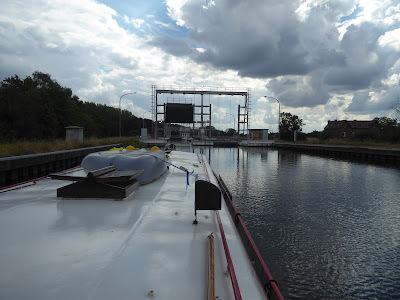 Approaching Ascenseur/ Lift 1
Approaching Ascenseur/ Lift 1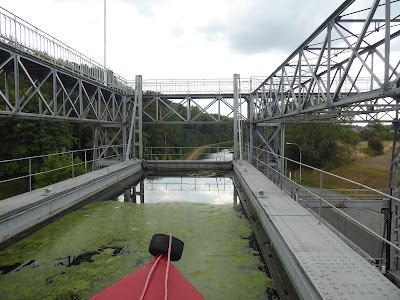 Entering the caisson
Entering the caisson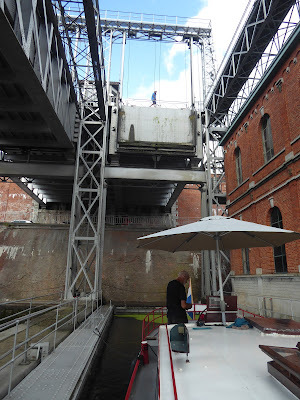 Looking back up after we'd descended
Looking back up after we'd descended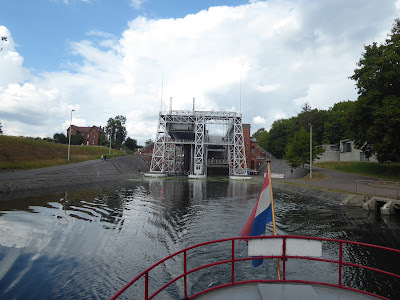 Leaving lift 1
Leaving lift 1It was very special for us to be living this history on our own Hennie H. Lift 1 has a drop of just under 16 metres, which is deeper than any of the locks we'd been through. Even more impressive is the fact the mechanisms operating this and all the lifts are original. They work on a hydraulic counterbalancing system in that while one caisson rises, the other descends. What surprised us, though, was how they adjust the balance. If the descending caisson is not heavy enough to lower steadily, water is released from its rising partner. In addition, more water is poured into the descending caisson from the canal above. I have to say this was something of a shock as they didn't warn us, so to see two waterfalls suddenly gushing into our caisson from a dizzy height was not what we were expecting. Nevertheless, it was a simple and highly effective solution, because down we went at a much improved pace.
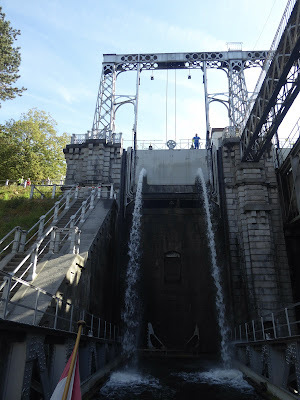 Increasing the weight of our caisson. This
Increasing the weight of our caisson. Thiswas later, but the system was the same.
Because it was quite late in the day, we opted to stay the night on the canal and do the other three lifts the following morning. Our obliging lock-keeping team arranged to be ready for us at 10 a.m. and we found ourselves a pleasant spot to spend the night close to the bridge at Houdeng. Our descent of the lift had been in cloudy and slightly rainy weather, but it soon cleared up and we had a lovely evening of golden sunshine, helped by a bottle of plonk from the nearby Aldi supermarket!
The following morning, we set off in good time and headed towards Lift 2, which was around two kilometres further along the canal. What we hadn't taken into account when we booked our passage was the low swing bridge (also a historic monument) about halfway along where we had to wait for the dream team to reach us. They'd probably thought we'd only arrive there at 10 o'clock, so we caught them on the hop a bit.
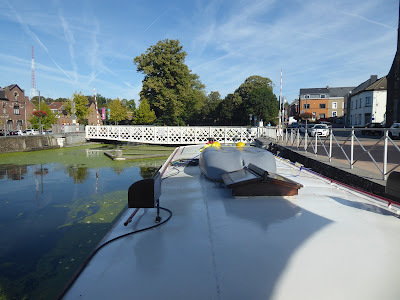 The historic swing bridge at Houdeng Goegnies
The historic swing bridge at Houdeng GoegniesLifts 2 and 3 are very close together and both just under 17 metres deep. It was a beautiful morning and I loved being able to see the next lift as we descended Lift 2 in our green duckweed tank. The whole canal surface was covered in weed for long stretches, but it was very thin, so gave us no problems.
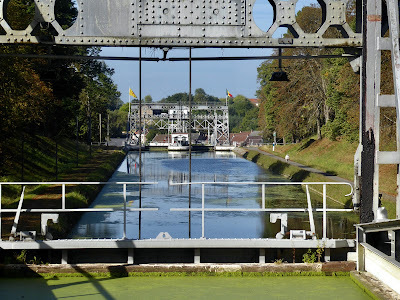 Descending lift 2
Descending lift 2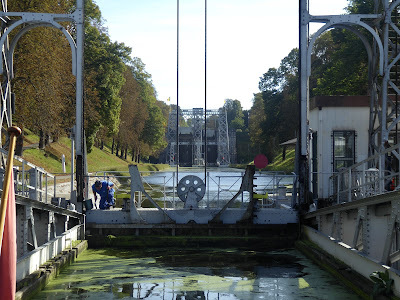 In the Lift 3 caisson
In the Lift 3 caisson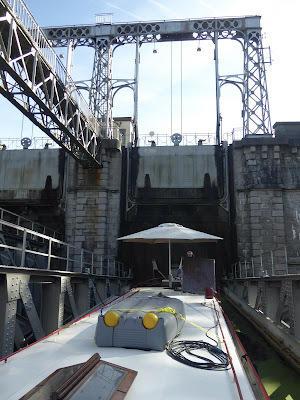 At the bottom of Lift 3
At the bottom of Lift 3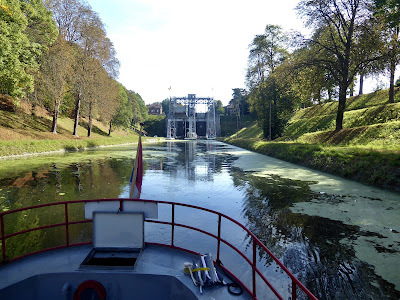 And on our way to cover the final few kilometres to Lift 4
And on our way to cover the final few kilometres to Lift 4The canal to the last lift at Thieu is also quite a stretch. I don't remember exactly how long it is but it must be over three kilometres. There's another pretty historic bridge, this time a lifting one, and our attendant looked on anxiously as we passed through it in case we caught our umbrella on the steel. All was well, though, and we were through for the final leg.
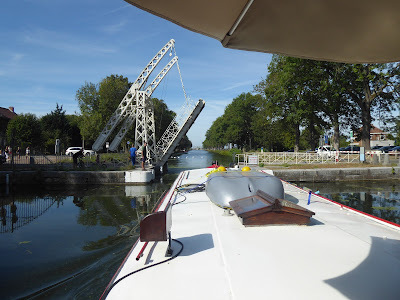 Our umbrella gave the attendant an anxious moment
Our umbrella gave the attendant an anxious momentAnother highlight as we made our way towards Lift 4 was looking through the trees and spotting the great Strépy Thieu lift dominating the scenery as it does for miles around. It was a lovely moment of relativity to see it there from our own passage through its historic predecessors.
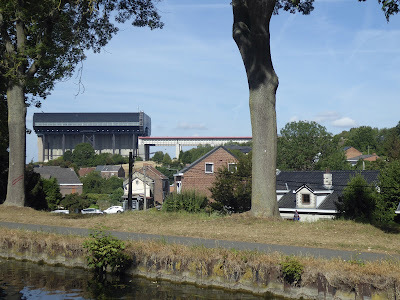
The final lift in the stretch was a fitting end to the experience. The view from the caisson is quite breathtaking, looking out as it does over the wide basin at its foot and then further over the golden Wallonian hills on the other side of the new Canal du Centre. What many don't realise is that there is still a further six-metre lock to descend before reaching main waterway, meaning that we were still at quite a height. As a grand finale, the panoramic vista was hard to beat and I was so pleased we'd been able to take this time to 'do' these lifts.
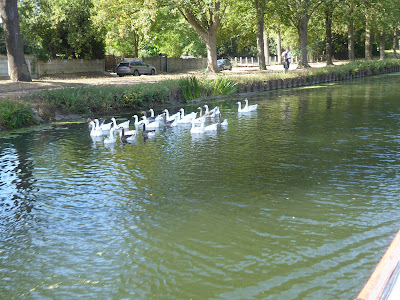 The resident geese. They've been there for years.
The resident geese. They've been there for years.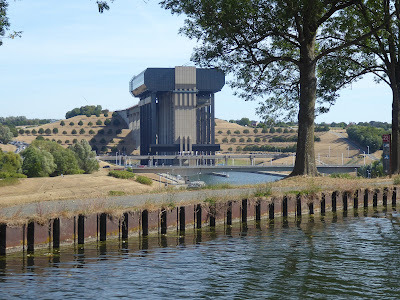 From the old canal to the new. What a sight!
From the old canal to the new. What a sight!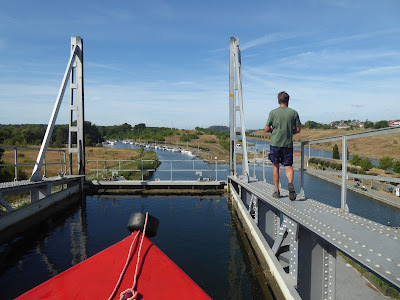 A stunning view across the basin to the hills beyond
A stunning view across the basin to the hills beyond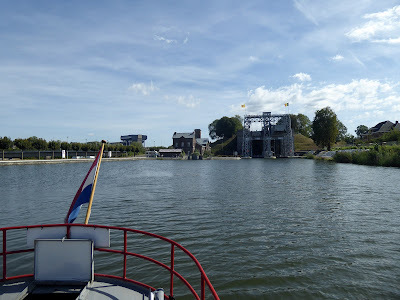 Leaving Lift 4 and waiting to go down the final lock.
Leaving Lift 4 and waiting to go down the final lock.So, Don and Cathy Jo, I hope you (and everyone else) have enjoyed the trip. It was one of the highlights of our travels this year and we were fortunate to be blessed with both the weather and the time to do it. For anyone visiting, there are passenger boats that do tours of all the lifts, as well as two visitors' centres where information about the construction and mechanics of these hydraulic marvels is readily available. We've been to this old stretch of canal by road many times, but nothing can beat experiencing the living history of this waterway by faring through it ourselves.
Have a great weekend allemaal, and I hope the world is kind to you in the coming week.



